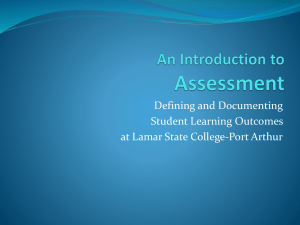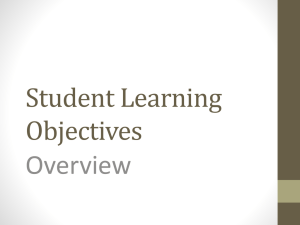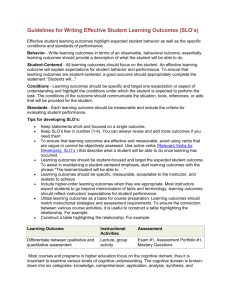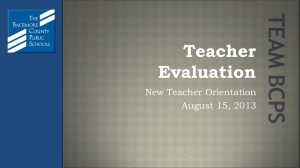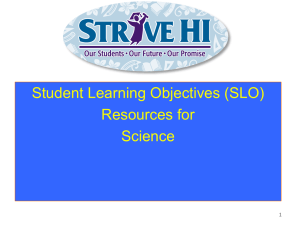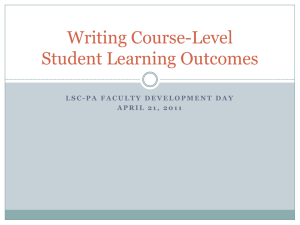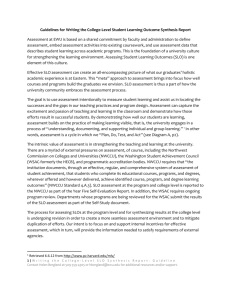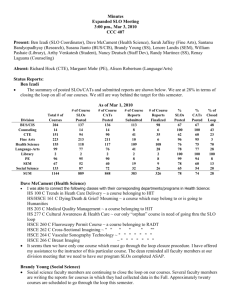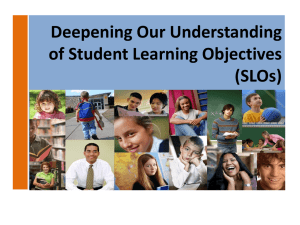PowerPoint - Language Learning Center
advertisement
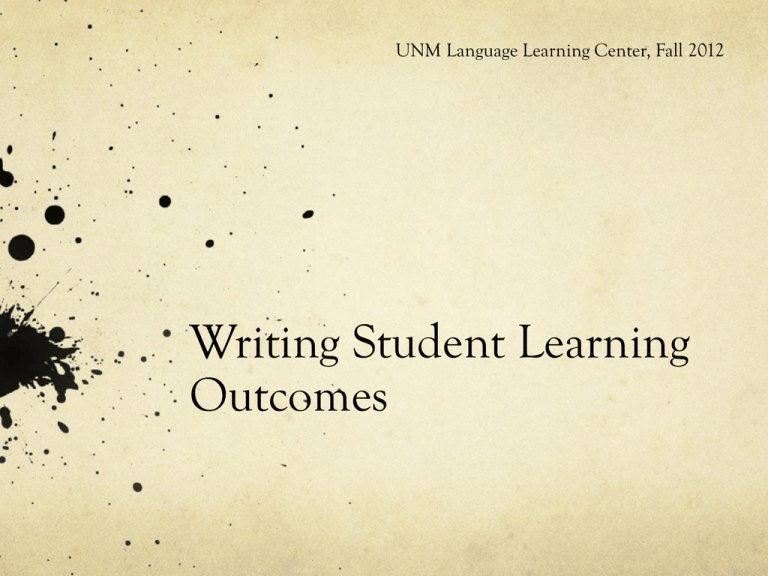
UNM Language Learning Center, Fall 2012 Writing Student Learning Outcomes What’s the Point? • Student Learning Outcomes (SLOs) are the blueprint for your course. • Once you create SLOs, you will use them as guides to create learning activities. • What you want students to learn and be able to do should guide the choice and design of the assessment. Goals vs. SLOs Goal – describes the student will learn in the course in broad terms. Ex: By the end of this course, the student will have a basic understanding of modern Brazilian culture. SLOs are discreet units that will add up to meet the goal. Difference Between Goals & Objectives Goals are broad; objectives are narrow. Goals are general intentions; objectives are precise. Goals are intangible; objectives are tangible. Goals are abstract; objectives are concrete. Goals can't be validated as is; objectives can be validated. SLOs SLO – describes specifically what the student will be able to do after completing the course Can be observed, measured and demonstrated Start with phrase “Students will be able to…” Use action verbs Don’t combine SLOs SLO Samples Well written SLO: By the end of course, students will be able to describe the effects of the Black Plague on wages in 14th century France. Poorly written SLO: Students will learn about the Black Plague in France. What Is It? By the end of course, the student will understand French grammar. Students will be able to identify the 3 properties of color. Students will learn about the importance of theater in Brazil. By the end of the course, the student will know how to tie a Blake’s Hitch Importance of Action Verbs Action verbs result in overt behavior that can be observed and measured. Analyze, apply, argue, arrange, assemble, assess, calculate, categorize, choose, classify, compare, compile, compute, create, criticize, critique, defend, define, demonstrate, describe, design, develop, differentiate, discuss, distinguish, estimate, examine, explain, formulate, identify, illustrate, indicate, interpret, label, list, locate, manage, memorize, order, operate, organize, plan, practice, predict, prepare, propose, question, rate, recognize, repeat, report, reproduce, review, revise, schedule, select, solve, state, translate, use, utilize, write Verbs to Avoid Certain verbs are unclear and call for covert, internal behavior which cannot be observed or measured. Avoid: Appreciate, become aware of, become familiar with, know, learn, understand Ex. of bad SLO: Students will gain an understanding of art in America. Examples Too general and HARD to measure… …will appreciate the benefits of exercise. (potential goal statement though) Specific and relatively EASY to measure… …will be able to explain 3 ways that exercise affects stress. Is It an SLO? Is It a Good SLO? Students will be able to define thaumaturgy and explain the etymology of the term. Students will know how to greet a stranger in Portuguese. By the end of this course students will be able to identify the most frequently encountered endings for nouns, adjectives and verbs, as well as some of the more complicated points of grammar, such as aspect of the verb Students will learn the lifestages of a frog. Students will explain the results from World War I and World War II. Students will be able to read basic material relating to current affairs using appropriate reference works, where necessary. Break Down the Goal SLOs are based on the overarching goal. What does the student need to learn to achieve the goal? Break down the goal into its logical component parts. Goal: By the end of this course, the student will have a basic understanding of the reign of King Henry the XIII. SLOs: By the end of course, students will be able to: SLO #1: Determine the influences on English law that stem from his reign SLO #2: Discuss the impact on religion in England as a result of his reign Break It Down AGAIN SLO #2: Discuss the impact on religion in England as a result of his reign 1. Discuss the reasons for Henry’s break with Rome 2. Discuss the consequences of Henry’s break with Rome 3. Differentiate between Henry’s reformation and the Reformation outside of England Learning Activities & Assessments SLO: Discuss the reasons for Henry’s break with Rome Practice: In pairs, one person representing Henry’s side and the other representing the Church of Rome, debate the issue of Henry’s annulment. Quiz: Rearrange events into the correct time sequence. Project 1: Create a multimedia presentation that demonstrates the effects of Henry’s actions on the Reformation. Bloom’s Taxonomy Higher order thinking skills Lower order thinking skills Bloom’s 2 Remember: Can the student recall or remember the information? Understand: Can the student explain ideas or concepts? Apply: Can the student use the information in a new way? Analyze: Can the student distinguish between the different parts? Evaluate: Can the student justify a stand or decision? Create: Can the student create new product or point of view? http://ww2.odu.edu/educ/roverbau/Bloom/blooms_taxonomy.htm Resources Writing Objectives Using Bloom's Taxonomy http://teaching.uncc.edu/articles-books/best-practice-articles/goals-objectives/writingobjectives-using-blooms-taxonomy A Model of Learning Objectives http://www.celt.iastate.edu/teaching/RevisedBlooms1.html Adds the “Knowledge Dimension” How to Write Objectives/OutcomesHow to Write http://www.assessment.uconn.edu/docs/HowToWriteObjectivesOutcomes.pdf Bloom’s Taxonomy http://ww2.odu.edu/educ/roverbau/Bloom/blooms_taxonomy.htm Teaching Resources – Bloom’s Taxonomy http://at.ccconline.org/faculty/wiki/Teaching_Resources_-_Other_Resources__Blooms_Taxonomy Align with Program Goals Go back to program goals and see how well your SLOs align with them. 1.1 Students will analyze literary, cultural, and/or linguistics texts within their historical, social, and theoretical or literary contexts. 1.2 Students will compose essays applying argumentative techniques and documentation that demonstrate understanding of texts. 2.0 Students will present information, concepts, and analyses orally using diverse vocabulary and complex grammatical structures. 3.0 Students will engage in interpersonal communication with peers and superiors demonstrating fluency, accuracy, and an awareness of culturally appropriate vocabulary, values, and behavior.
